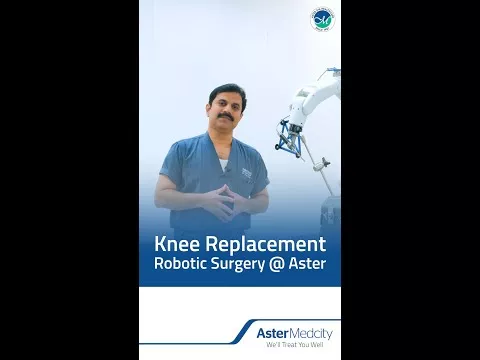What is Total Knee Replacement?
Total knee replacement, also known as total knee arthroplasty, is a surgical procedure used to treat severe knee joint damage and relieve chronic knee pain that cannot be effectively managed with conservative treatments. It involves replacing the damaged or worn-out parts of the knee joint with artificial components. The knee joint is composed of three major bones: the femur (thighbone), the tibia (shinbone), and the patella (kneecap). The ends of these bones are covered with cartilage, which allows smooth movement within the joint. Over time, this cartilage can wear away due to factors such as arthritis, injury, or other degenerative conditions, resulting in pain, stiffness, and difficulty in performing daily activities.
During a total knee replacement surgery, the surgeon makes an incision over the knee joint and removes the damaged portions of the femur and tibia. The ends of these bones are then reshaped to accommodate the artificial components. The artificial joint consists of metal alloys and high-grade plastics, designed to replicate the function of a healthy knee joint. The components used in total knee replacement typically include a metal femoral component, a metal tibial baseplate, a plastic spacer, and in some cases, a plastic patellar component. These components are secured to the remaining bone with bone cement or through press-fit techniques that encourage natural bone growth into the prosthesis. Once the artificial components are in place, the surgeon tests the knee's range of motion, checks the stability, and ensures proper alignment. The incision is then closed, and the patient is moved to a recovery area.
After the surgery, physical therapy and rehabilitation are essential for the patient to regain strength, restore mobility, and optimize the function of the new knee joint. With time and proper rehabilitation, most individuals experience significant pain relief and improved knee function, allowing them to resume normal activities and enjoy a better quality of life. It's important to note that total knee replacement surgery is a major procedure that carries risks and requires careful evaluation by a healthcare professional. The decision to undergo this surgery is typically made after conservative treatment options, such as medications, physical therapy, and lifestyle modifications, have been exhausted. The final decision is usually made in consultation with an orthopedic surgeon based on the patient's specific condition and the severity of knee joint damage.
Why and when Total Knee Replacement is recommended?
Total knee replacement is recommended when conservative treatments no longer provide sufficient relief from knee pain and mobility limitations caused by severe knee joint damage. It is typically considered when the following conditions are met:
Osteoarthritis: The most common reason for total knee replacement is osteoarthritis, a degenerative condition where the cartilage in the knee joint gradually wears away, causing pain, stiffness, and reduced mobility. When the pain becomes chronic and significantly affects daily activities, despite non-surgical treatments, total knee replacement may be recommended.
Rheumatoid arthritis: This autoimmune disease causes inflammation in the joints, including the knee joint. When rheumatoid arthritis leads to severe joint damage, resulting in persistent pain and loss of function, total knee replacement may be an option.
Post-traumatic arthritis: Significant knee joint damage resulting from a severe injury or fracture can lead to post-traumatic arthritis. When this condition causes debilitating symptoms that impair daily activities, total knee replacement may be considered.
Knee deformities: Certain congenital conditions or acquired deformities, such as bowed legs or knock knees, can cause uneven wear and tear on the knee joint, leading to pain and difficulty in walking. Total knee replacement may be recommended to correct the alignment and improve function.
Other conditions: Total knee replacement may also be recommended for individuals with other knee joint conditions, such as avascular necrosis (loss of blood supply to the bone), tumors, or knee joint infections that have not responded to other treatments.
The decision to undergo total knee replacement is typically made by the patient in consultation with an orthopedic surgeon. The surgeon evaluates the individual's overall health, the severity of the knee joint damage, and the impact of symptoms on daily life. They consider factors such as the patient's age, activity level, and medical history to determine if total knee replacement is appropriate.
Is Robotic Knee Replacement possible? If yes, what are the benefits?
Yes, robotic-assisted knee replacement is a specialized technique that is gaining popularity in the field of orthopedic surgery. Robotic knee replacement combines advanced imaging technology, computer software, and robotic systems to assist surgeons during the procedure. While the surgeon remains in control, the robotic system provides real-time feedback and precision guidance, enhancing the accuracy and outcomes of the surgery.
Here are some potential benefits of robotic knee replacement:
Enhanced Precision: Robotic systems use preoperative imaging to create a 3D virtual model of the patient's knee joint. This allows the surgeon to plan the surgery with exceptional accuracy, including determining the optimal size, alignment, and placement of the artificial components. During the procedure, the robotic arm assists the surgeon in executing the surgical plan precisely, helping to achieve optimal alignment and balance of the joint.
Customization: Robotic systems can assist in achieving a more personalized approach to knee replacement. The virtual model generated by the system allows for customization based on the patient's specific anatomy and alignment needs. This can lead to better outcomes, improved joint function, and potentially increased longevity of the artificial joint.
Improved Implant Positioning: Accurate implant positioning is crucial for the long-term success of knee replacement surgery. Robotic systems can provide real-time feedback to the surgeon, assisting in precise placement of the artificial components. This can result in improved joint stability, better range of motion, and potentially reduced risks of complications such as implant wear or loosening.
Reduced Tissue Trauma: Robotic-assisted techniques are often associated with smaller incisions and less soft tissue trauma compared to traditional knee replacement surgery. The robotic arm's guidance can help the surgeon make precise bone cuts, potentially reducing disruption to healthy tissues surrounding the knee joint. This can lead to faster recovery, less postoperative pain, and shorter hospital stays.
Enhanced Patient Outcomes: While the long-term clinical evidence on the benefits of robotic knee replacement is still evolving, initial studies suggest potential advantages in terms of improved joint
alignment, reduced revision rates, and better patient-reported outcomes, such as pain relief and functional recovery.
It's important to note that robotic knee replacement is a specialized technique that requires advanced training and expertise. The availability of robotic systems may vary depending on the healthcare facility and surgeon. As with any surgical procedure, individual outcomes may vary, and it's essential to consult with an experienced orthopedic surgeon to determine the most appropriate treatment approach based on your specific condition.
How is life after Total Knee Replacement?
Life after total knee replacement can vary from person to person, but for many individuals, it can significantly improve their quality of life. Here are some general aspects to consider:
Reduced Pain: One of the primary goals of total knee replacement is to alleviate chronic knee pain. Many people experience a significant reduction in pain following the procedure. This can enable individuals to engage in activities that were previously limited or avoided due to knee pain.
Improved Mobility: Total knee replacement can restore mobility and range of motion in the knee joint. After the recovery and rehabilitation period, individuals often find it easier to perform daily activities, such as walking, climbing stairs, and getting in and out of chairs. Improved mobility can enhance independence and overall functionality.
Enhanced Quality of Life: With reduced pain and improved mobility, individuals often report an overall improvement in their quality of life. They can participate in recreational activities, hobbies, and social events that were challenging before the surgery. Improved knee function can also lead to better sleep quality and mental well-being.
Increased Functionality: Total knee replacement can restore the functionality of the knee joint, allowing individuals to perform tasks with greater ease. This includes activities such as kneeling, squatting, and bending the knee, which may have been difficult or impossible before the surgery.
Long-Term Durability: The artificial components used in total knee replacement are designed to be durable and long-lasting. While the lifespan of the prosthetic joint can vary, many people experience successful outcomes for 15 to 20 years or more. However, it's important to follow the surgeon's instructions for post-operative care, maintain a healthy lifestyle, and attend regular follow-up appointments to ensure the longevity of the replacement joint.
Rehabilitation and Maintenance: Rehabilitation plays a crucial role in optimizing outcomes after total knee replacement. Physical therapy and exercises are typically prescribed to strengthen the muscles around the knee joint, improve flexibility, and enhance overall knee function. Following the recommended rehabilitation program and adopting a healthy lifestyle can help maintain the benefits of the surgery and minimize the risk of complications.
It's worth noting that recovery and outcomes can vary based on individual factors such as age, overall health, and adherence to rehabilitation guidelines. It's important to have realistic expectations and work closely with your healthcare team to ensure the best possible recovery and long-term results.
Blogs
The source of trustworthy health and medical information. Through this section, we provide research-based health information, and all that is happening in Aster Hospital.




